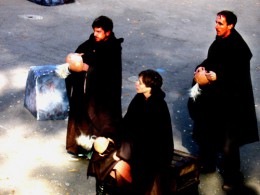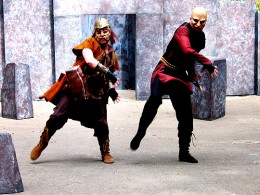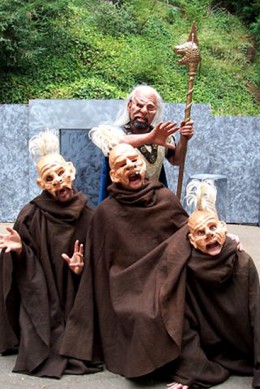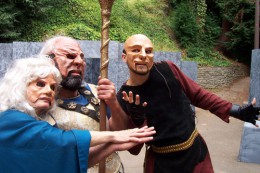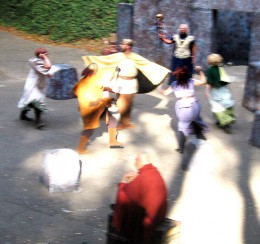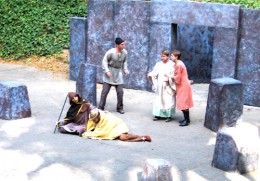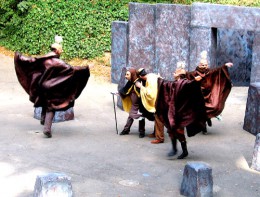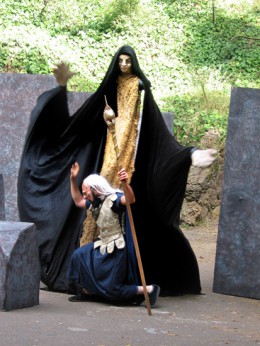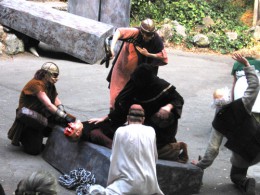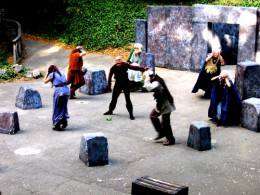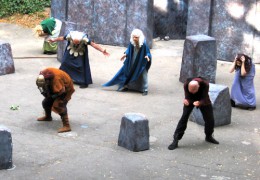The ancient Norse equivalent of the Apocalypse. The Gods see themselves under dire threat of attack by the Primal Ones, and, in the name of security, methodically set up the means of their own self-destruction.
Written by Conrad Bishop & Elizabeth Fuller
Directed by Conrad Bishop, music by Elizabeth Fuller
Set & masks by Michael Frassinelli
Costumes by Christine Crook
Two acts; 6m/4w; unit set.
Produced by Shotgun Players in collaboration with The Independent Eye, premiering on July 22, 2006, at Hinkel Park Amphitheatre (Berkeley, CA). 17 performances.
From the program:
The stories that inspire this play are mainly from the Poetic Edda, a 13th Century collection of Old Norse poems, and the Prose Edda, compiled around 1220 by the Icelandic scholar Snorri Sturluson.
These tales were already ancient myth at the time of the writing, and probably had the same distortions of personal interpretation, inspired additions, selective deletions, and human confusions that any contemporary playwright makes in dealing with mythic or historic sources.
We look at the past—whether we call it history or myth—in the way we look at a pond’s surface, seeing a few things beneath the water but struck most strongly by our own reflection. And as any politician knows, the past becomes the story we tell about it. More dangerously: we become the story we tell about it.
Now, both of us are in our sixties, we’ve lived our entire lives among the imagery of mass annihilation, from the fictions of space invaders or city-crushing monsters to the realities of the H-bomb, vast dumps of plutonium, AIDS, global warming. And we’ve seen the enemy morph from the Nazis to the Commies to the Terrorists, all apparently coming from Outer Space with neither rhyme nor reason behind their mad, mad eyes.
And yet, like the Players in this play, we’ve chosen to make entertainment from this lethal wreckage of the human soul. Why, one Player asks, don’t we make songs and plays about the nine months of a baby being born? There’s nothing special in that, the other replies, it’s the killing that makes the story. The best we can do, as the ancient Edda poet did, is to find a sprig of hope, even if at the end of the world.
For us, the brightest side of Earth’s problematic experiment with the human species is the very persistence of this nutty urge to tell stories. Happy or sad, hopeful or bitter, bloody or mystical, full of truth or of lies, lies, lies—we still keep weaving the fabric of our newborns’ swaddling clothes. Wherever one story ends, there’s another pressing to be told.
Who can say, if some day an alien species lands in Alameda County, whether they’ll find only roaches, or perhaps remnants of the species that regarded itself as the very purpose of the universe. But we hope at least that they’ll find our stories. And wonder at them.
—Bishop & Fuller
—Robert Hurwitt, San Francisco Chronicle“Why do we worship the gods if they’re already dead?†Helga asks, reasonably enough. Bishop and Fuller raise the question not so much theologically as socially, asking us to re-examine our part in the age-old worship of the warrior and whether it’s a good idea, as Loki proposes, to “put our trust in fear.â€
—Ken Bullock, Berkeley Daily PlanetThe ensemble of ten pulls out the stops to tell the story of the pagan gods awaiting their long-heralded doom, running through the changes of a variety of modes: “Presentational Theater,†Physical Theater, storytelling, a kind of pageantry, song, dance, and very impressive puppets for Loki’s monstrous brood which make brief but effective appearances. This isn’t Wagner’s Gotterdämmerung, but something more intimate, to be told in a wintery hall at a feast, or in a summer glen, to kill time. The gods prove to be the ultimate party animals, killing time (and a few Strange Ones along the way) engagingly, as they slip ever nearer the awaited brink. . . .
And underpinning it all is a very topical anxiety: security, the trade-off between Love and safety emphasized over and over. Is the return of Thor’s hammer worth the loss of the goddess of Love as a hostage bride? Or is the building of unbreachable walls for their haven, Asgard (or, as the red-nosed Funny One with the hardhat calls it in Texan, “Ass-Gardâ€), an exchange for Freya, who makes life worth living, who is in fact the wellspring and continuity of life itself? . . .
This post-Christian, secular Humanist-ized treatment of myth veers back and forth between the irony of Plato and the burlesque of a Fractured Fairy Tales cartoon. It ends with a round dance, Loki in the middle, representing the long-awaited disaster, heralded by a bugler (no archangel) who complains he’s never blown the thing. And it does end on a note of hope—life goes on, the unborn baby kicking, a slip from Yggdrasil, the World Tree, potted up.
